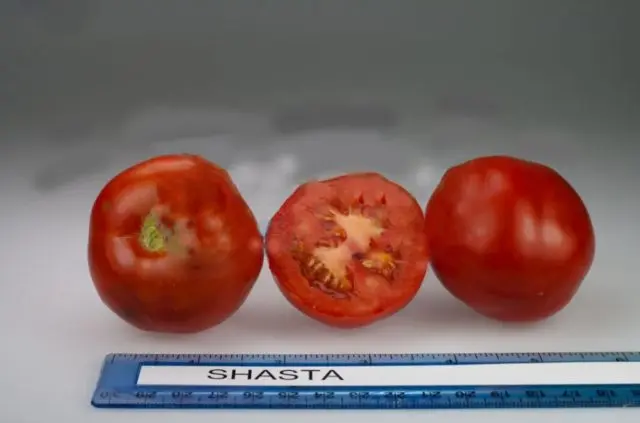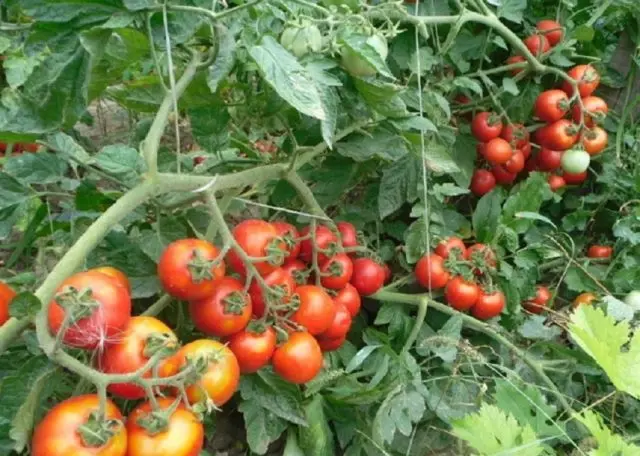Contents
The Shasta F1 tomato is the world’s earliest high-yielding determinant hybrid developed by American breeders for commercial use. The originator of the variety is Innova Seeds Co. Thanks to ultra-early ripening, excellent taste and commercial qualities, high yields, and resistance to many diseases, gardeners also fell in love with Shasta F1 tomatoes.
Description of Shasta tomato
F1 Shasta tomatoes are of the determinate type. Such plants stop growing in height when forming at the top of the flower brush. Determinate tomato varieties are a great option for summer residents who want to get an early and friendly harvest.
In the case of the Shasta F1 tomato variety, with the formation of a sufficient number of brushes, growth stops at the level of 80 cm. The bush is powerful, stocky, with a large number of ovaries. Shasta F1 requires a tie to the support, it is simply necessary in case of high yields. The grade is ideally suited for cultivation on fields for industrial purposes. The leaves are large, dark green in color, the inflorescences are simple, the stalk has a joint.
Tomato Shasta F1 has the shortest growing season – only 85-90 days pass from germination to harvest, that is, less than 3 months. Due to early maturation, Shasta F1 is sown directly in open ground, without using seedlings. Some summer residents successfully grow Shasta F1 tomatoes in spring greenhouses, shaping them as a tall indeterminant. Such agricultural technology significantly saves the shortage of greenhouse space, and the result of the work of the gardener will be the earliest spring tomatoes.

Shasta F1 is a fairly new variety; it was entered into the State Register in 2018. It is zoned according to the North Caucasian and Nizhnevolzhsky regions.
Brief description and taste of fruits
The fruits of the Shasta F1 variety are round in shape with barely noticeable ribbing, they are smooth and dense. On one brush, an average of 6-8 tomatoes are formed, almost identical in size. An unripe tomato is green in color with a characteristic dark green spot at the stem, a ripe one has a rich red-scarlet color. The number of seed nests – 2-3 pcs. The mass of fruits fluctuates in the range of 40-79 g, most tomatoes weigh 65-70 g. The yield of marketable fruits is up to 88%, ripening is friendly – more than 90% turn red at the same time.
F1 Shasta tomatoes have a sweet tomato flavor with a slight pleasant sourness. The content of solids in the juice is 7,4%, sugars – 4,1%. Shasta tomatoes are ideal for whole-fruit canning – their skin does not crack, and their small size allows you to use almost any container for pickling and salting. Due to their unsurpassed taste, these tomatoes are often consumed fresh, and they are also used to prepare tomato juice, pasta, and various sauces.
Varietal characteristics
Shasta tomato is grown both in large agricultural enterprises and in private gardens. The fruits have a presentable appearance and are distinguished by good transportability. Shasta F1 is an indispensable variety for the fresh vegetable market, especially at the beginning of the season. Shasta tomatoes can be harvested manually and mechanically with a combine harvester.
The yield of tomato variety Shasta F1 is quite high. With industrial cultivation in the conditions of the North Caucasus region, 1 tons of marketable fruits can be harvested per 29,8 ha, when grown on the Lower Volga – 46,4 tons. The maximum yield according to state test statistics is 91,3 tons per 1 ha. From one bush per season, you can remove 4-5 kg of tomatoes. Reviews about the yield of the Shasta F1 tomato with photos illustrating a huge number of ovaries appear with enviable regularity.

Several factors influence the yield of a crop:
- seed quality;
- proper preparation and sowing of seeds;
- strict selection of seedlings;
- soil quality and composition;
- regularity of fertilizer application;
- correct watering;
- hilling, loosening and mulching;
- pinching and removing excess leaves.
Shasta F1 has no equal in terms of maturation. Only 90 days pass from spitting the first sprouts to ripe bulk tomatoes. Harvest ripens amicably, the variety is suitable for rare collections. It tolerates hot weather well, but requires regular watering.
Tomato Shasta F1 is resistant to verticillium, cladosporiosis and fusarium, it can be affected by black leg. In case of infection with fungal diseases, the diseased bush is dug up and burned, the remaining plantings are treated with a fungicide solution. Among the most common pests of tomatoes are:
- whitefly;
- naked slugs;
- spider mite;
- Colorado beetle.
Pros and cons of the variety
Among the undeniable advantages of Shasta F1 tomatoes over other varieties, the following can be distinguished:
- early and friendly ripening of fruits;
- high yield;
- more than 88% of marketable fruits;
- long shelf life fresh;
- good transportability;
- dessert, sweet taste with slight sourness;
- the peel does not burst during heat treatment;
- suitable for whole canning;
- tolerates heat well;
- the variety is resistant to the main diseases of nightshade;
- the ability to grow in the fields;
- high profitability.
Among the shortcomings, it is worth noting:
- the need for timely watering;
- the possibility of infection with a black leg;
- collected seeds do not convey the properties of the mother plant.
Rules of landing and care
Due to the short growing season, Shasta F1 tomatoes in most cases are sown immediately in a permanent place, without the stage of growing seedlings. In the garden, recesses are made at a distance of 50 cm from each other, several seeds are thrown, covered with soil and covered with a film until the first shoots appear. The timing of planting Shasta tomatoes varies depending on the region, you need to focus on the temperature regime: 20-24 ° C – during the day, 16 ° C – at night. To improve the quality of fruits, organic fertilizers are applied to the soil in advance of sowing.
The first thinning of tomatoes is done when the seedlings have 2-3 leaves. The strongest are left, the distance between neighboring plants is 5-10 cm. The second time the tomatoes are thinned out at the stage of formation of the 5th leaf, the distance increases to 12-15 cm.

At the last thinning, the extra bushes are carefully dug out with a clod of earth, if desired, they can be transplanted to a place where the seedlings were weak. After transplantation, the tomatoes are shed with a solution of “Heteroauxin” or “Kornevin”, or sprayed with the preparation “HB-101” (1 drop per 1 liter of water). This will reduce the stress caused by moving to a new location.
Seeding for seedlings
Sowing Shasta F1 tomatoes directly into the ground is good only for the Southern regions. In the middle lane, seedlings are indispensable. Tomato seeds are sown in low containers with nutritious universal soil or a mixture of sand and peat (1: 1). It is not necessary to pre-disinfect and soak the planting material, the appropriate processing is carried out at the manufacturer’s factory. The containers are covered with foil and placed in a warm place with an average temperature of 23°C.
At the stage of formation of the 2nd-3rd leaf, tomato seedlings dive into separate pots and begin to harden, taking them out into fresh air. Caring for young tomatoes includes regular watering and top dressing. Also, the container with tomato seedlings must be rotated relative to the light source, otherwise the plants will stretch and be one-sided.
Seedling transplant
Tomatoes of the Shasta F1 variety, like other varieties, are planted in open ground when a warm average daily temperature is established. The distance between neighboring plants is 40-50 cm, at least 30 cm. Each bush is carefully removed from the pot, trying not to damage the root system, placed in a pre-dug hole and sprinkled with soil. Landings are watered with warm water and mulched.
Care of plantings
To prevent pests and diseases, planting tomatoes are regularly weeded from weeds, mulched and loosened the soil. This improves the access of oxygen to the roots and has a beneficial effect on the growth and development of the tomato bush, and, therefore, on the yield. Watering Shasta tomatoes is carried out as the soil dries.
Hybrid Shasta F1 does not require the removal of stepchildren and extra leaves. Each plant, as it grows, is tied to an individual support so that the stem does not break under the weight of the fruit.
Throughout the growing season, tomatoes must be fed regularly. As fertilizers, a solution of mullein, urea, as well as chicken manure is used.
Conclusion
Tomato Shasta F1 – a new worthy variety with an early fruiting period. Bred for commercial cultivation, it fully justifies its description – it ripens amicably, most of the marketable tomatoes grow well in the field. Shasta is also suitable for private gardens, the good taste of these ultra-early tomatoes will be appreciated by the whole family.









